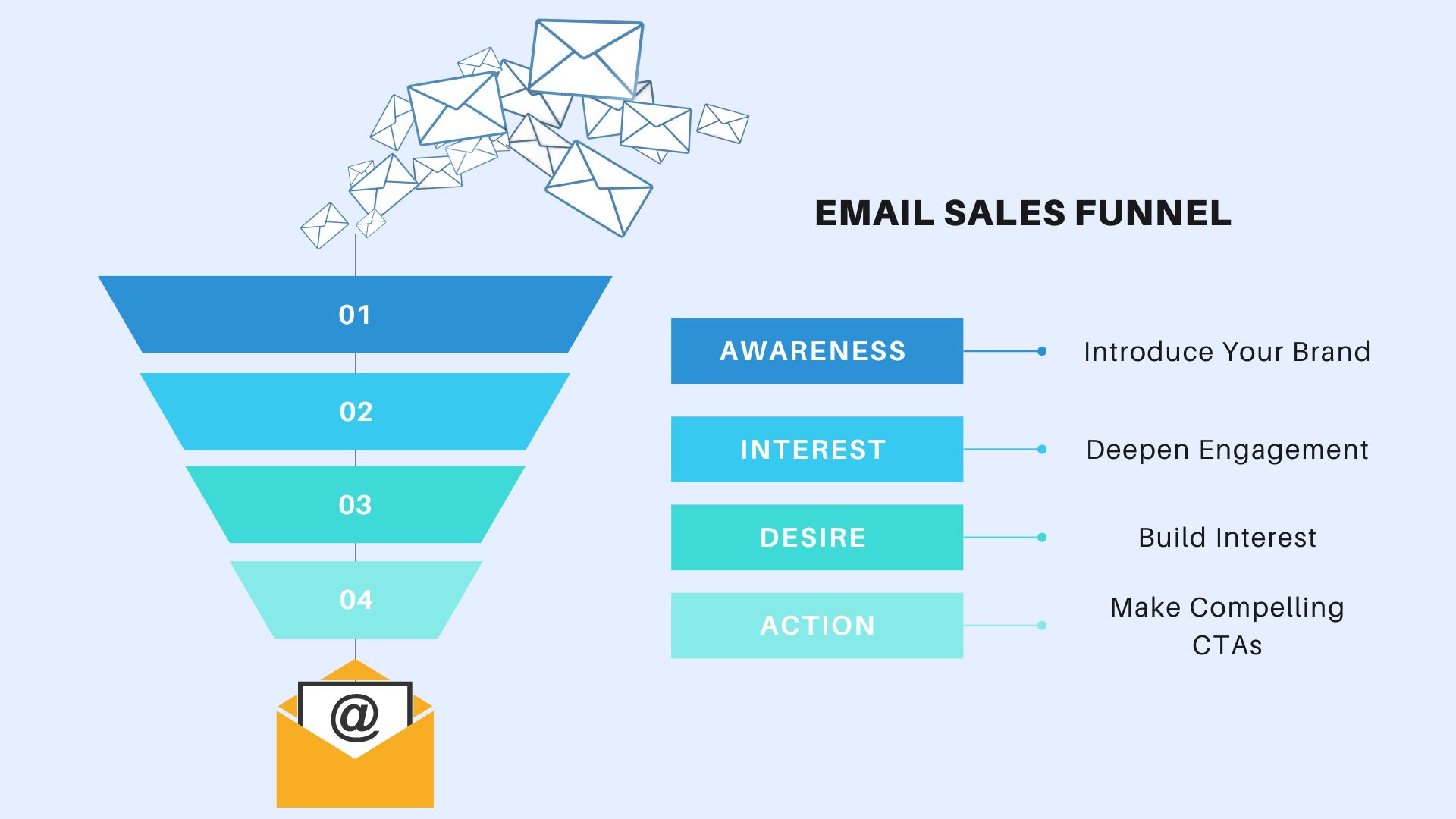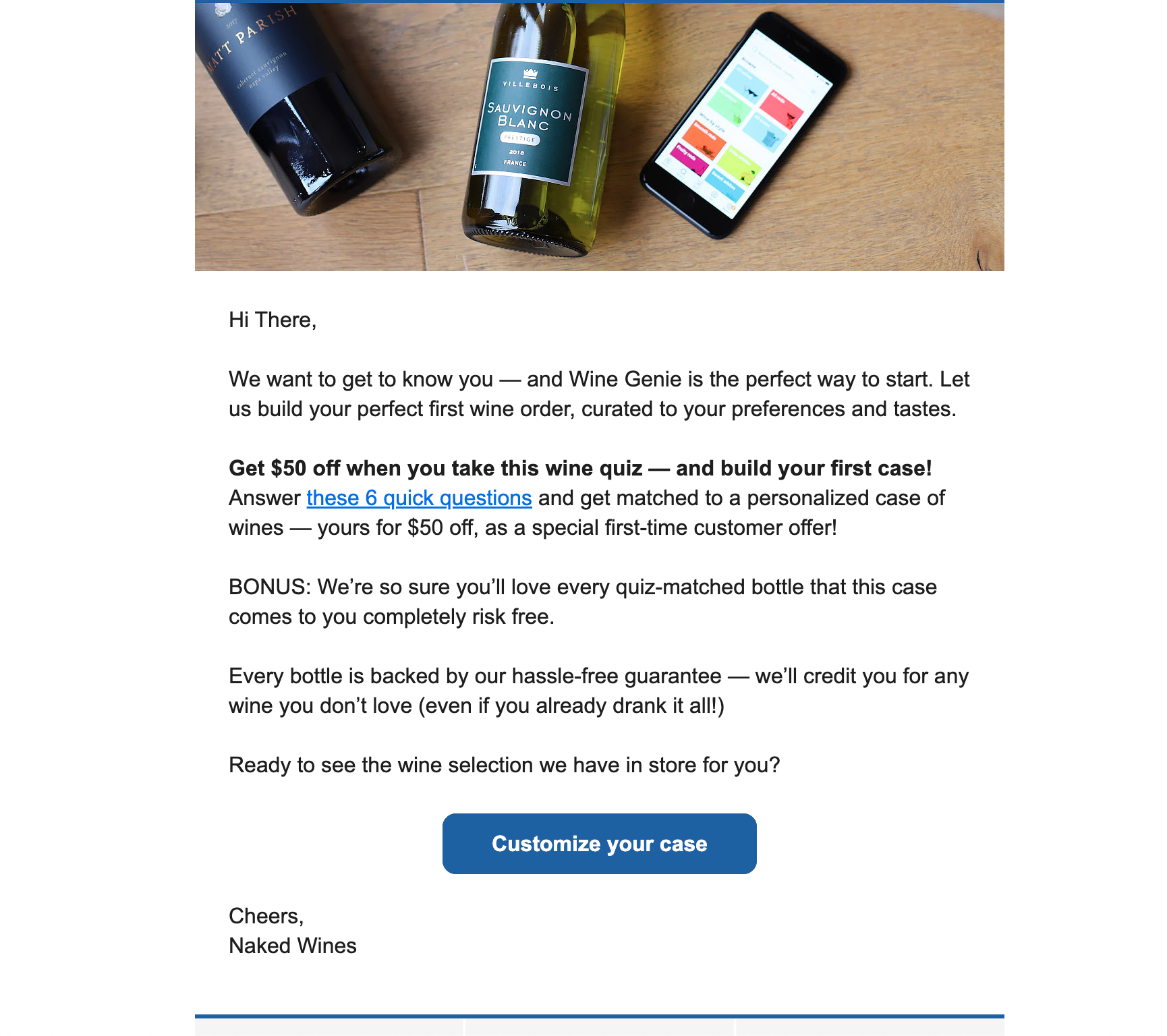The email marketing funnel is a strategic approach that businesses use to guide their subscribers through a series of carefully crafted emails with the goal of converting them into paying customers.
It follows a step-by-step process designed to nurture leads, build trust, and ultimately drive sales. Let’s cover how to create efficient email marketing funnels that garner more leads and customers.
Table of Contents
- What Are Email Funnels?
- The Stages of an Email Funnel
- Stage 1: Awareness
- Stage 2: Interest
- Stage 3: Desire
- Stage 4: Action
- The Different Types of Email Funnels
- Welcome Funnels
- Nurture Funnels
- Sales Funnels
- Re-engagement Funnels
- Upsell/ Cross-sell Funnels
- Conclusion
What Are Email Funnels?
An email funnel typically consists of several stages, starting with the awareness phase, where subscribers are introduced to the brand and its offerings. This is followed by the interest stage, where engaging and informative emails are sent to capture the attention of the subscribers and deepen their interest.
You can capture the attention and keep your audience engaged with TruVISIBILITY's Messaging application, which allows you to set automated messages and keep track of your marketing efforts.
The next stage is desire, where emails focus on highlighting the benefits and value of the products or services, creating a desire to make a purchase. Finally, the action stage prompts subscribers to take the desired action, such as making a purchase, signing up for a webinar, or scheduling a consultation.

The Stages of an Email Funnel
This common email funnel strategic framework guides subscribers through a series of stages, each designed to move them closer to becoming paying customers. Let’s dive into the various stages of an email marketing funnel, understanding their purpose, and exploring the key strategies and techniques involved in each stage.
Stage 1: Awareness
The awareness stage marks the beginning of the email marketing funnel. At this stage, subscribers are introduced to your brand and its offerings. The primary goal is to create brand awareness and capture the attention of potential customers.
Key strategies in this stage include a compelling welcome email series, which sets the tone for future interactions, and content that educates and informs subscribers about the benefits of your products or services. By focusing on building trust and credibility, businesses can establish a solid foundation for the subsequent stages of the funnel.
Stage 2: Interest
Once subscribers are aware of your brand, the interest stage aims to deepen their engagement and cultivate their interest in your offerings. In this stage, businesses should focus on delivering valuable and relevant content that resonates with the subscribers' needs and desires.
Segmentation plays a crucial role here, as it allows you to tailor your messages based on subscribers' preferences and behaviors. Personalized product recommendations, case studies, and testimonials are effective strategies to pique their interest and showcase the value of your offerings.
Additionally, providing exclusive content, such as ebooks or white papers, can further engage subscribers and position your brand as an industry authority.
Stage 3: Desire
The desire stage is where the focus shifts to creating a strong desire for your products or services. Building on the interest generated in the previous stage, businesses should highlight the unique selling propositions and benefits of their offerings.
Use persuasive copywriting techniques to showcase how your product or service can solve a specific problem or fulfill a need.
Testimonials, success stories, and social proof can further enhance the desire for your offerings. Additionally, limited-time offers, discounts, or exclusive deals can create a sense of urgency and encourage subscribers to take action.
Stage 4: Action
The action stage is the ultimate goal of the email marketing funnel. At this point, subscribers are ready to make a purchase or take the desired action. The key strategies in this stage involve crafting compelling calls-to-action (CTAs) that clearly communicate the next steps to subscribers. Whether it's directing them to a product page, a signup form, or a checkout process, the CTAs should be visually appealing, concise, and prominently placed within the email.

Photo Credit: Naked Wines
It is also essential to provide a seamless user experience, ensuring that the landing pages or forms align with the content and design of the emails. A/B testing can be valuable in optimizing CTAs and improving conversion rates. Furthermore, nurturing leads who haven't taken immediate action can be achieved through automated follow-up sequences, reminders, or personalized offers.
The Different Types of Email Funnels
Email sales funnels are not all size fits all. This is why we want to dive a bit deeper into each kind of email campaign, touching on how the sales funnel for these may look a bit different from the traditional mold.
Welcome Funnels
The welcome funnel is one of the most common types used by businesses to introduce new subscribers to their brand. It typically consists of a series of automated emails sent immediately after someone signs up.
The main goal of the welcome funnel is to establish a positive first impression, provide valuable information about the brand, and set expectations for future communications. The emails in this funnel can include a warm welcome message, an overview of the company's values and mission, educational content, and a call-to-action to engage further with the brand.
Nurture Funnels
Nurture funnels are designed to build relationships and engage subscribers over time. These funnels focus on delivering relevant and valuable content to educate, inform, and address the needs of the subscribers.
By nurturing leads, businesses can establish trust, position themselves as industry experts, and gradually move subscribers towards making a purchase. Nurture funnels often involve a series of emails that provide educational resources, case studies, customer testimonials, and exclusive offers.

Photo Credit: Hungryroot
The key is to deliver the right content at the right time based on subscribers' behavior, interests, and preferences. By segmenting the audience and tailoring the messaging accordingly, businesses can significantly increase engagement and conversion rates.
Sales Funnels
Sales funnels are specifically designed to guide subscribers towards making a purchase. These funnels are highly focused on driving conversions and typically target subscribers who have already shown interest in the product or service.
The emails in a sales funnel are designed to showcase the benefits, features, and unique selling propositions of the offering. They may include persuasive copywriting, testimonials, limited-time offers, and compelling calls-to-action. Sales funnels often have a clear progression from introducing the product to presenting social proof, addressing objections, and closing the sale.
By carefully crafting the messaging and utilizing automation, businesses can effectively move subscribers through each stage of the sales funnel and boost conversion rates.
Re-engagement Funnels
Re-engagement funnels are employed to win back inactive or disengaged subscribers. These funnels target individuals who haven't interacted with the brand or opened emails for a specific period.
The objective is to reignite their interest and bring them back into the sales cycle. Re-engagement funnels typically begin with a gentle reminder email, acknowledging the subscriber's absence and offering an incentive or exclusive content to entice them.
If there is no response, subsequent emails may include additional incentives, personalized recommendations, or surveys to gather feedback. The aim is to understand the reasons for disengagement and tailor the content to regain their attention and rekindle their interest.
Upsell/Cross-sell Funnels
Upsell/cross-sell funnels target existing customers with the goal of increasing their average order value. These funnels focus on promoting complementary or upgraded products or services to customers who have already made a purchase.
The emails in this funnel highlight the benefits, features, and value of the additional offerings, presenting them as valuable extensions of the customer's initial purchase. Upsell/cross-sell funnels may include personalized recommendations based on previous purchases, exclusive discounts for existing customers, and testimonials showcasing the enhanced benefits of the service or product.
Conclusion
Throughout the email marketing funnel, businesses utilize various techniques like personalization, segmentation, and targeted messaging to deliver relevant content that resonates with the subscribers' needs and interests. By effectively implementing an email marketing funnel, businesses can enhance customer engagement, drive conversions, and build long-term relationships with their audience.
By registering with a freemium account, you get unlimited access to fully functional software free of cost. As your business grows, you only pay for what you use without any contract. A freemium TruVISIBILITY account allows you to:
- Create a chatbot that can conduct up to 100 conversations per month
- Launch email blasts, start drip campaign, etc with 1000 free emails sent monthly
- Send 1000 SMS texts per month
- Build 1 website including a blog
- 1 GB of storage usage
- 1 SSL certificate
- Unlimited API usage
The pricing is very simple; it's based on usage over the free monthly allotment. Thus it is extremely affordable for small to medium businesses. You can adjust the number of conversations your chatbots can have, the number of emails and SMS that can be sent per month, the number of websites you can deploy, and the capacity of your cloud storage. Simple and flexible!
Want to receive more articles?
Sign-up for our weekly newsletter to receive info that will help your business grow



